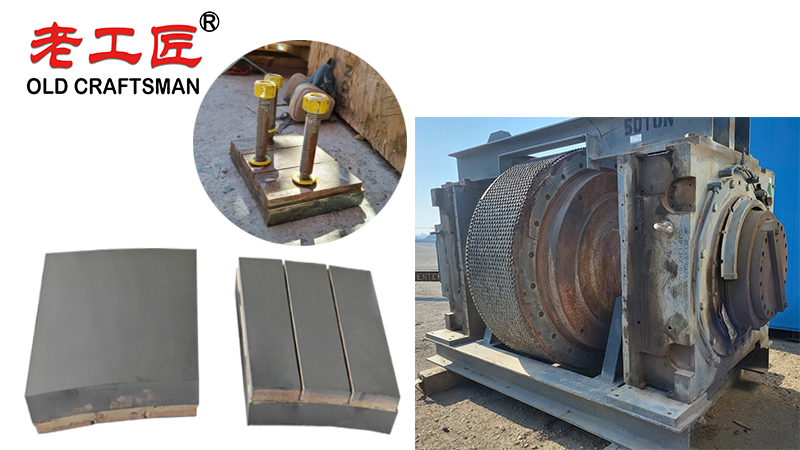High-Pressure Grinding Rolls (HPGRs) are critical equipment in the mining and aggregate industries for comminution (crushing and grinding) of hard ores and rocks. The flanges, or studs, are the key wear components on the roll surface, directly responsible for applying immense pressure to the material bed.
While the rolls themselves are often made of tough alloy steel, their surfaces are studded with tungsten carbide (WC) flanges for one primary reason: unmatched wear resistance in an exceptionally abrasive environment.

1. The Hostile Environment of an HPGR
To understand the advantage, one must first appreciate the operating conditions:
- Extreme Abrasion: The flanges are in constant, sliding contact with a bed of hard, sharp mineral particles (e.g., iron ore, diamond ore, copper ore).
- Immense Pressure: HPGRs operate with pressures ranging from 50 to 300 MPa (MegaPascals), forcing abrasive particles into every microscopic imperfection on the flange surface.
- High-Impact Loads: While primarily a compression machine, the feed can contain large, hard lumps that create significant impact stress on the flanges.
In this environment, standard steel flanges would wear down in a matter of hours or days, leading to catastrophic failure, excessive downtime, and high replacement costs.
2. The Inherent Properties of Tungsten Carbide
Tungsten carbide is a composite material, typically consisting of hard tungsten carbide grains cemented together by a ductile cobalt binder. This combination delivers a set of properties perfectly suited to combat HPGR wear.
| Property | Explanation | Why it Matters for HPGR Flanges |
|---|---|---|
| Extreme Hardness | Tungsten carbide has a Vickers hardness (HV) of ~1,400-1,800, compared to ~200-800 for hardened steels. | This hardness is superior to most mineral abrasives. It resists cutting, scratching, and gouging, preventing the material from “plowing” into the flange surface. |
| High Compressive Strength | WC has a compressive strength over 600 ksi, significantly higher than any steel. | It can withstand the colossal operating pressures of the HPGR without deforming or crumbling, maintaining its profile and integrity. |
| Exceptional Wear Resistance | This is a direct result of its high hardness and microstructural integrity. | It is the single most important property. It drastically reduces the rate of material loss, extending flange service life from days (for steel) to many months or even years. |
| Good Fracture Toughness | While brittle compared to steel, modern WC grades are engineered with a cobalt binder to provide sufficient toughness. | This allows the flange to absorb the impact from large feed lumps and the high-stress cycles without cracking or spalling. |

3. The Direct Advantages in HPGR Operation
The superior properties of tungsten carbide translate into significant operational and economic benefits:
1. Dramatically Extended Service Life:
This is the most significant advantage. A tungsten carbide flange can last 10 to 20 times longer than a hardened steel flange. This directly translates to:
- Reduced frequency of roll rebuilds and flange replacements.
- Maximized machine availability and uptime.
2. Consistent Grinding Performance:
As tungsten carbide flanges wear, they do so slowly and predictably, maintaining a sharp and effective profile for a longer portion of their life. This ensures:
- Consistent product size distribution.
- Stable power draw and throughput.
- Avoidance of the performance drop-off seen with rapidly wearing steel flanges.
3. Lower Total Cost of Ownership (TCO):
Although the initial cost of tungsten carbide flanges is higher than steel, their vastly extended lifespan means the cost per ton of processed material is significantly lower. This TCO calculation includes:
- Reduced parts costs over time.
- Massive savings on labor and downtime associated with replacements.
- Higher overall process efficiency.
4. Reduced Risk of Catastrophic Failure:
A steel flange that wears down too quickly can expose the softer roll body to abrasion, leading to irreversible and costly damage to the entire roll. Tungsten carbide’s resilience protects this core, multi-million dollar asset.
Comparison: Tungsten Carbide vs. Hardened Steel Flanges
| Feature | Tungsten Carbide Flanges | Hardened Steel Flanges |
|---|---|---|
| Wear Life | Months to Years | Days to Weeks |
| Initial Cost | High | Low |
| Cost per Ton | Very Low | Very High |
| Hardness | Extremely High (HV 1400-1800) | High (HV 200-800) |
| Impact Resistance | Good (requires proper grade selection) | Excellent |
| Operational Impact | Stable, predictable performance | Rapid performance degradation |

Conclusion
The use of tungsten carbide in HPGR flanges is not merely an improvement; it is a fundamental enabling technology for the economic viability of high-pressure grinding. Its unparalleled wear resistance, derived from a unique combination of extreme hardness and robust toughness, directly confronts the most destructive aspect of the HPGR’s operation.
By choosing tungsten carbide, operators shift their focus from constant maintenance and high variable costs to achieving maximum throughput, process stability, and the lowest possible cost per ton of processed material. This wear resistance advantage is the cornerstone of reliable and profitable HPGR performance in modern mineral processing.
“Zhuzhou Old Craftsman Precision Alloy Co., Ltd. could make tungsten carbide wear parts and make your equipment use life is tens of times longer than before! We specialize in providing customized carbide wear products solutions to meet the demanding requirements of industries such as aerospace, automotive, mining, and precision machining.”
Belt scarper Brazing brazingprocess CARBDIE HAMMER carbide Carbide belt scraper carbidebrazing carbide hammer Crusher CRUSHER HAMMER Informational Internal stress metal mining mold operate Refractory Brick Mold Secondary belt cleaner scraper stresses VSI VSI crusher wear plates welding work